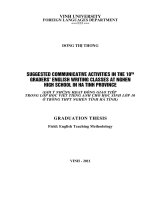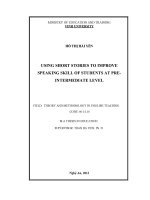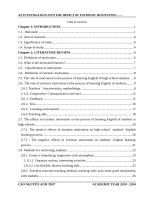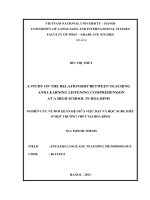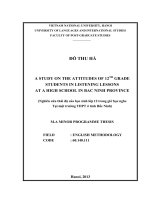Using the flipped classroom model as a vocabulary teaching aid for the new ‘tiếng anh 11’ to enhance EFL learning of students at a high school in ha noi
Bạn đang xem bản rút gọn của tài liệu. Xem và tải ngay bản đầy đủ của tài liệu tại đây (1.83 MB, 98 trang )
VIETNAM NATIONAL UNIVERSITY, HANOI
UNIVERSITY OF LANGUAGES AND INTERNATIONAL STUDIES
FACULTY OF POST-GRADUATE STUDIES
------
KIỀU THỊ THU THỦY
USING THE FLIPPED CLASSROOM MODEL AS A VOCABULARY
TEACHING AID FOR THE NEW „TIẾNG ANH 11‟ TO ENHANCE
EFL LEARNING OF STUDENTS AT A HIGH SCHOOL IN HA NOI
(Sử dụng mô hình lớp học đảo ngược làm công cụ hỗ trợ việc giảng dạy từ vựng cho
sách giáo khoa “Tiếng Anh 11” chương trình thí điểm nhằm nâng cao hiệu quả học
tập ngoại ngữ của học sinh tại một trường THPT ở Hà Nội)
M.A MINOR PROGRAMME THESIS
Field
: English Teaching Methodology
Code
: 8140231.01
Hanoi, 2020
VIETNAM NATIONAL UNIVERSITY, HANOI
UNIVERSITY OF LANGUAGES AND INTERNATIONAL STUDIES
FACULTY OF POST-GRADUATE STUDIES
------
KIỀU THỊ THU THỦY
USING THE FLIPPED CLASSROOM MODEL AS A VOCABULARY
TEACHING AID FOR THE NEW „TIẾNG ANH 11‟ TO ENHANCE
EFL LEARNING OF STUDENTS AT A HIGH SCHOOL IN HA NOI
(Sử dụng mô hình lớp học đảo ngược làm công cụ hỗ trợ việc giảng dạy từ vựng cho
sách giáo khoa “Tiếng Anh 11” chương trình thí điểm nhằm nâng cao hiệu quả học
tập ngoại ngữ của học sinh tại một trường THPT ở Hà Nội)
M.A MINOR PROGRAMME THESIS
Field
: English Teaching Methodology
Code
: 8140231.01
Supervisor : Prof. Dr. Hoàng Văn Vân
Hanoi, 2020
DECLARATION
I, the undersigned, declare that this thesis is the results of my own
research and has not been submitted to any other university or institution
partially or wholly. Except where the reference is indicated, no other person‟s
work has been used without due acknowledgement in text of the thesis.
Student
Kiều Thị Thu Thủy
In my capacity as supervisor of the candidate‟s thesis, I certify that the
above statements are true to the best of my knowledge.
Supervisor
Prof. Dr. Hoang Van Van
i
ACKNOWLEDGEMENTS
First of all, the researcher would like to express her gratitude to the
Dean, the Vice Dean and all staffs of the Faculty of Postgraduate Department
for their priceless wisdom, encouragement, help and kindness during her
study and writing this thesis.
In the second place, she wishes to extend her great honor and deepest
gratitude to her adviser, Prof. Dr. Hoang Van Van, for his invaluable
guidance, correction, facilitation and encouragement in the writing of this
thesis.
Her special thanks also are forwarded to Mr. Khuat Dang Khoa, the
Headmaster of the High School where she is working, who had permitted her
to conduct this research in his school. Her thanks are presented to all the
English teachers of the school‟s English group for their help and advice
during the implementation of the research. And then, her great thanks are
extended to students of class 11A4 (school year: 2017-2018) for their
cooperation during the time the research was conducted.
Finally, she would like to thank her family, her friends for their spirit,
encouragement and their support. Without them this thesis couldn‟t be
accomplished.
ii
ABSTRACT
To master all four language skills, vocabulary is very essential to
successful communication. Understanding this need and the problems that
learners face during learning English, this action research was conducted with
the aim at improving students‟ English language learning through Flipped
Classroom Model technique to the eleventh graders at a high school in Ha Noi
in the academic year of 2017-2018 and investigating their attitudes toward
this technique. Forty three participants were involved in the research during
16 weeks of the second term. The present study was concerned with using
Flipped Classroom techniques as a vocabulary teaching aid by administering
pre-test, post-test and questionnaire as the research instruments. The results
showed that students‟ achievements in all four language skills were higher
after the intervention. Although the general achievement was not so
impressive, it however indicates that Flipped Classroom Model is still an
effective learning method and worth applying in English language teaching
and learning. Besides, most of the students showed their agreement on the use
of Flipped Model as it helped them to be more motivated, active, and engaged
in learning. It also created a friendly learning environment where students felt
more confident, cooperative and responsible during learning process. In
general,
Flipped
Classroom
Model
academically, socially and psychologically.
iii
improved
students‟
outcomes
TABLE OF CONTENTS
DECLARATION ........................................................................................................i
ACKNOWLEDGEMENTS ..................................................................................... ii
ABSTRACT ............................................................................................................. iii
TABLE OF CONTENTS .........................................................................................iv
LIST OF ABBREVIATION ....................................................................................vi
LIST OF TABLES ................................................................................................. vii
LIST OF FIGURES .............................................................................................. viii
PART A: INTRODUCTION ....................................................................................1
PART B: DEVELOPMENT.....................................................................................5
CHAPTER 1: LITERATURE REVIEW ................................................................ 5
1.1. Definition of key terms ........................................................................................5
1.1.1. Vocabulary and Vocabulary Teaching .............................................................5
1.1.2. Vocabulary and integrated four language skills ...............................................7
1.1.3. Flipped Classroom ............................................................................................7
1.1.4. Traditional Classroom and Flipped Classroom ...............................................9
1.2. Theoretical Framework ......................................................................................11
1.3. Elements of the Flipped Classroom Model ........................................................15
1.4. Advantages of FC Model ...................................................................................16
1.5. Previous Studies .................................................................................................16
1.6. Strategy to Conduct FC Model ..........................................................................23
CHAPTER 2: METHODOLOGY .........................................................................25
2.1. Rationale for Choosing Action Research ...........................................................25
2.2. Procedure............................................................................................................27
2.3. Research Setting .................................................................................................29
2.4. Textbook ............................................................................................................30
2.5. Hypotheses of the Study.....................................................................................32
2.6. Data Collection Instruments ...............................................................................33
iv
2.7. Intervention ........................................................................................................35
2.8. Study Timetable and Data Analysis ...................................................................36
2.9. Summary ............................................................................................................40
CHAPTER 3: THE PRESENTATION OF THE FINDINGS ............................ 41
3.1. Data Tabulation and Description .......................................................................41
3.2 Data Analysis ......................................................................................................43
3.2.1. Findings Related to Research Question One: .................................................43
3.2.2 Findings Related to Research Question Two ...................................................46
3.3 Discussion of the Findings ..................................................................................48
3.3.1 Achievement ....................................................................................................48
3.3.2 Attitudes ...........................................................................................................49
PART C: CONCLUSION AND RECOMMENDATION ...................................50
1. Conclusion.............................................................................................................50
2. Limitations of the Study ........................................................................................51
3. Recommendations .................................................................................................53
REFERENCES ........................................................................................................54
APPENDICES ........................................................................................................... I
v
LIST OF ABBREVIATION
FC Model Flipped Classroom Model
ELT
English Language Teaching
EFL
English as a foreign language
F2F
Face to face
vi
LIST OF TABLES
Table 1. Definitions of Flipped learning. ..................................................................17
Table 2. Tabulation of data showing the subjects‟ scores through FC model ..........41
Table 3. Students‟ responses to the two „open-ended‟ questions ............................. 43
Table 4. Summary of the research finding showing the mean score from pre-test and
post-test of four language skills ................................................................................44
vii
LIST OF FIGURES
Figure 1: Comparison of traditional classroom and flipped classroom ....................10
Figure 2. Synthesis of the models and theories associated with flipped learning.....14
Figure 3. Synthesis of learning processes in flipped learning ..................................15
Figure 4. Action research cycle .................................................................................28
Figure 5.The students‟ progress in each language skills through FC model ............45
Figure 6. The progressing of grand mean in students‟ achievement thanks to
application of FC model ............................................................................................ 46
viii
PART A: INTRODUCTION
In this chapter, the background to the problem and the reason for
choosing the topic are mentioned. As a result, the necessity of delivering the
research as well as the importance of the application of FC Model as a
vocabulary teaching aid in improving students' language learning is revealed.
The aims and the significances of the study are also stated. The final section
will present the scope of the study which shows the number of participants,
the time of the intervention and the design of the research.
1. Rationale
English has become the compulsory subject in the educational
curriculum in Vietnam. In implementing the Prime Minister‟s 2008 Decision
No. 1400/QĐ–TT about the National Foreign Language 2020 project, the
Vietnamese Ministry of Education and Training started to design the new
curriculum and new English textbook series from primary to upper secondary
school with an aim to „form and develop English language communication
competence‟.
The new series of English textbooks for upper secondary school is
being used for pilot teaching in most upper secondary school together with the
old textbooks in the first and second phases of this Project. At the high school
where I am working now, the new textbooks „Tiếng Anh 10‟, „Tiếng Anh 11‟
and „Tiếng Anh 12‟ have also been employed as textbooks for 3 classes of
each grade.
For the research topic, I have come up with this topic since I taught the
new „Tiếng Anh 10‟ to three classes of grade-10 students last year. The series
of the piloted textbooks for English subject are very helpful with real-life
topics. They provide students with various sources of vocabulary. Vocabulary
1
learning is an important and indispensable part of any language learning
process. Second or foreign language vocabulary acquisition has been an
increasingly interesting topic of discussion for researchers, teachers,
curriculum designers, theorists and others involved in second/foreign
language learning.
In fact, second/foreign language learners often cite lack of adequate
vocabulary as one of the most common obstacles to performances in foreign
language classes. However, with 45 minutes per lesson, it is challenging for
an English teacher to cover all the vocabulary items related to the relevant
topics in the series of the newly-piloted textbooks “Tieng Anh 10”, “Tieng
Anh 11” and “Tieng Anh 12. Due to the limited time for a lesson, the teacher
has to choose five to seven words to teach and explain to the students. This
causes a learning problem for the students‟ English language learning. To
help them address the problem, the flipped classroom approach (FC) is tried
as a vocabulary teaching aid for the new „Tiếng Anh 11‟ to promote my
students‟ English language learning.
2. Significance of the Study
Theoretically, this thesis is a small contribution to the theory of ELT on the
impacts of flipped classroom in vocabulary teaching in EFL classrooms.
Practically, this study is firstly expected to be an alternative way to expose the
students to more student-centered English lessons, and secondly to help them
enhance their English language learning motivation.
3. Aim of the Study
The aim of this research is to add to the body of knowledge and help
provide data to investigate how well students learn English through the
piloted textbook „Tiếng Anh 11‟ by using the flipped classroom model as a
vocabulary teaching and learning aid.
2
4. Research questions
To fulfill the aim, the study raises two questions for exploration:
Question 1: To what extent does the integration of the FC model as a
vocabulary teaching aid for „Tiếng Anh 11‟ affect students‟ English
language learning?
Question 2: What are the students‟ attitudes toward the integration of
FC model for English language learning?
5. Scope of the Study
This minor thesis attempts to investigate the impacts of the FC model
as a vocabulary teaching aid for the new „Tiếng Anh 11‟ on students‟
English language learning and their attitudes toward the integration of
the FC model for EFL learning.
The subjects of the study include 43 students from a grade-11 class at a
high school on the outskirts of Hanoi.
The study limits its scope to vocabulary teaching aid for the new „Tiếng
Anh 11‟ by using FC model to improve students‟ English language
learning because investigating all kinds of vocabulary teaching
activities are such broad topics that they cannot be wholly discussed
within the framework of this paper.
In terms of English vocabulary learning, the scope of this research is
confined
to the teaching-learning of the following topics in the
textbook due to time constraint:
- Global warming (Unit 6)
- Further Education (Unit 7)
- World Heritage Sites (Unit 8)
- Cities of the Future (Unit 9)
- Healthy Lifestyle and Longevity (Unit 10)
3
6. Design of the study
This study is divided into three parts:
PART A: THE INTRODUCTION - presents the rationale for the
study, the aims to which the study is conducted, the research questions, the
scope, the significance of the study, the research method and the design of the
study.
PART B: THE DEVELOPMENT consists of three chapters.
Chapter I: Literature Review - provides the definitions of some key
terms, and the previous research related to the study as well as the gaps in the
field which inspire the writer to conduct the research
Chapter II: Methodology - describes the research method, the
participants, the textbook, and the method to collect and analyze the data.
Chapter III: The presentation of the findings - presents the data
tabulation and description, data analysis and discussion of the findings.
PART C: CONCLUSION - briefly summarizes the study; besides,
some limitations of the study and recommendations for further research are
also proposed.
4
PART B: DEVELOPMENT
CHAPTER 1: LITERATURE REVIEW
This chapter presents the definitions of some key terms which are used
in the research. Significantly, an overview of previous studies about the
implementation of FC Model is provided. Some space is also devoted to the
discussion of the elements and advantages when applying FC Model in
teaching. Finally, the strategy of conducting FC Model which is used in this
research will be presented.
1.1. Definition of key terms
1.1.1. Vocabulary and Vocabulary Teaching
According to Kamil and Hiebert (2005), vocabulary is knowledge of
words and words meaning in both oral and print language and in productive
and receptive forms. Teaching language cannot be separated with teaching
vocabulary. Vocabulary is considered as an important component in English
language teaching and learning. According to Thornbury (2002), vocabulary
is a crucial aspect in learning a language as languages are based on words.
While Walters (2004) states that it is practically difficult to take in a language
without words, even correspondence between individual depends on words.
Both teachers and students agree that obtaining of the vocabulary is of focal
calculated educating a language.
Vocabulary is central to English language teaching because without
sufficient vocabulary students cannot understand others or express their own
ideas. Lewis (1993) went further to argue, “lexis is the core or heart of
language” (p. 89). Particularly as students develop greater fluency and
expression in English, it is significant for them to acquire more productive
vocabulary knowledge and to develop their own personal vocabulary learning
5
strategies. Students often instinctively recognize the importance of vocabulary
to their language learning. Teaching vocabulary helps students understand and
communicate with others in English. The concept of a word can be defined in
various ways, but three significant aspects teachers need to be aware of and
focus on are form, meaning, and use. According to Nation (2001), the form of
a word involves its pronunciation (spoken form), spelling (written form), and
any word parts that make up this particular item (such as a prefix, root, and
suffix). Nation (2001) stated that meaning encompasses the way that form and
meaning work together, in other words, the concept and what items it refers
to, and the associations that come to mind when people think about a specific
word or expression. Use, Nation noted, involves the grammatical functions of
the word or phrase, collocations that normally go with it, and finally any
constraints on its use, in terms of frequency, level, and so forth. For form,
meaning, and use, Nation (2001) declared there is both a receptive and
productive dimension, so knowing these three aspects for each word or phrase
actually involves 18 different types of lexical knowledge. When teachers
teach vocabulary to build students‟ knowledge of words and phrases, helping
them learn any and all of these different components assists them in
enhancing their English vocabulary knowledge and use in all language skills
such as reading, writing, speaking and listening.
Teaching vocabulary is more effective by putting the word of
vocabulary in context and indicating the use and function than deliver the
definition of vocabulary in dictionary.
In teaching vocabulary, the teacher as the class specialist is ought to
know the principles in doing it so that the students will get the purpose of
learning. The principles, as Linse (2006) claims, are as the following:
emphasize direct and indirect teaching, teach vocabulary words before a new
6
activity, teach students how to use context clues appropriately, present
multiple exposures to new vocabulary items, give opportunities for deep
processing of vocabulary items, teach students to use dictionaries, and have
students keep vocabulary notebooks.
1.1.2. Vocabulary and integrated four language skills
Vocabulary knowledge is often viewed as a critical tool for language
learners because a limited vocabulary impedes successful communication.
Nation (2001) describes the relationship between vocabulary knowledge and
language use as complementary: knowledge of vocabulary enables language
use and, conversely, language use leads to an increase in vocabulary
knowledge. In English as a second language (ESL) and English as a foreign
language (EFL), learning vocabulary items plays a vital role in all four
language skills (i.e. listening, speaking, reading and writing. Furthermore they
argue that the acquisition of an adequate vocabulary is essential for successful
second language use because without an extensive vocabulary, we will be
unable to use the structures and functions we may have learned for
comprehensible communication.
1.1.3. Flipped Classroom
Flipped classroom is an instructional strategy that reverses the
traditional learning environment by delivering instructional content, often
online, outside of the classroom. It moves activities, including those that may
have traditionally been considered homework, into the classroom. In a flipped
classroom, students watch online lectures, collaborate in online discussions,
or carry out research at home and engage in concepts in the classroom with
the guidance of a mentor. Flipped classroom is an emerging instructional
model that provides a fusion of online learning elements powered by
information technology and traditional face-to-face (F2F) learning elements,
7
which involves the advantages of both online and F2F instruction and
hopefully benefits teaching and learning EFL.
Inverting the classroom so that the transmission of information (lecture)
happens outside of class and the traditional out-of-class work is completed in
class with the teacher is not a recent concept. The researchers often credited
with first mentioning inverted learning, Lage, Platt and Treglia, published a
paper "Inverting the Classroom: A Gateway to Creating an Inclusive Learning
Environment" in 2000. In this article they explain that inverting the classroom
is an approach that occurs when “events that have traditionally taken place
inside the classroom now take place outside the classroom and vice versa.”.
Lage, Platt and Treglia (2000)s‟ results indicated that both students‟ and
teachers‟ perceptions of the new methodology were positive. Crouch and
Mazur (2001) conducted a study where they investigated the concept of peer
instruction that is in its essence similar to the flipped classroom in the sense
that transmission of information occurs outside of the classroom while class
time was devoted to conceptual questions and mini lectures which ideally
would include higher order thinking and assimilation. Strayer (2007)
published his dissertation entitled "The effects of the classroom flip on the
learning environment: a comparison of learning activity in a traditional
classroom and a flip classroom that used an intelligent tutoring system". This
study examined students‟ comfort with learning in an inverted classroom.
However, the term “flipped classroom” was not readily adopted till Bergman
and Sams, two chemistry teachers, started flipping their classroom by
providing the students with videos to watch at home and devoting class time
to projects. Their book Flip your classroom: reach every student in every class
every day (2012) outlines the concept of the flipped classroom and defines its
key elements. From this, we can note that the development of flipped learning
8
was organic and that the changes in the method, and therefore the definition,
mirrors technological developments in the world at large. Technology and
specifically social media has changed the way that information is transferred.
Therefore, at one point flipping the classroom included reading and/or the
dissemination of videotapes or even DVDs. However, now it is possible to
access, edit and disseminate videos easily so flipped classrooms have adapted
to match this technological transformation.
For this minor study, in a flipped classroom, the teacher posted a series
of videos to provide the students with vocabulary items and exercises to help
students revise what they learned in the videos. In the physical class, students
would use vocabulary they learned to participate in such class activities as
discussion, presentation, reading, listening, writing and speaking as well.
1.1.4. Traditional Classroom and Flipped Classroom
Flipped classrooms differ from traditional classes in many respects.
Traditional classes as opposed to flipped classrooms, include lectures, and
therefore transmission of information, in class (Talbert, 2012). In this
format, students often take notes during the lecture while in class. Outside of
class, students complete assignments that are often targeted at assimilation of
the information acquired during class time. This work is then submitted or
assessed in class. In this approach, individuals work outside of class either
alone or in groups but usually without the presence of an expert or a mentor.
The flipped classroom implies a reversal of the traditional class and
relies on a different process. There are a number of definitions of flipped
classrooms and they range from broad to specific depending on how the
teacher uses the method. The broadest definition of flipped learning is one
that proposes that assigning readings to give the students prior exposure to
new material is a form of flipped learning. The narrowest definition, on the
9
other hand, limits the concept of flipped learning to instances where educators
use technology, especially videos, to transmit information outside of class. In the
extant literature, the researchers who are often credited as the originators of the
flipped learning concept, Lage, Platt and Treglia (2000) defined flipping (or
inverting) the classroom as an instructional method in which “events that have
traditionally taken place inside the classroom now take place outside the
classroom and vice versa” (30-43). Interpretations of this definition can be quite
general and thus can create the idea of an unstructured classroom design;
however, using this definition as a starting point can provide teachers with a
certain amount of flexibility as well as give them the freedom to employ flipped
learning using various methods. One drawback when using this broad definition
of flipped learning is that it can be difficult to assess effectiveness. Other
researchers (Bishop and Vergler, 2013; Gannod, 2008; Enfield, 2013; Moroney
2013; Gaughan, 2014) have defined flipped classrooms narrowly and include
specific methods such as interactive group learning inside of the classroom and
videos outside of the classroom. In more pedagogical vernacular, this definition
means that the transmission of information takes place out of the classroom;
whereas assimilation takes place in the classroom (Talbert, 2012).
Figure 1: Comparison of Traditional Classroom and Flipped Classroom
10
1.2. Theoretical Framework
The theoretical framework of this project is based on the FC model.
The flipped classroom model shifts traditional activities such as lecture
outside the classroom. Instead, class time is used to engage students in
activities and discussion to reinforce what they have learned. The teacher or
instructor takes on the role of coach or facilitator (Baker, 2000).
The flipped classroom model can be invaluable for teachers because it
provides a way to repurpose classroom time by focusing on active learning,
student engagement, and hybrid course design. Therefore, class time is
viewed as a workshop. During workshops, students have opportunities to
engage in active learning by asking about lecture content, applying their new
knowledge, and interacting with their peers (EDUCASE, 2012). The FC
model does not refer to a single model. It can include online quizzes or
activities, videos, etc.
The FC model is regarded as a student-centered strategy. It empowers
students to become active learners, repositioning the teacher as a facilitator.
According to Baker (2000) and Mehring (2016), the model can be effectively
implemented in EFL classrooms. As Mehring (2016) states: „This process
opens up face to face class time, enabling teachers to interact with students by
discussing points of confusion, providing real-life examples relevant to course
content, challenging students to think more deeply about complex processes,
and monitoring learning activities‟ (p.2).
It is my belief that the flipped classroom model can help EFL
instructors focus on improving their students‟ communicative competence.
In terms of boosting EFL students' communicative competence in
English, it is possible to integrate CLT's characteristics in EFL countries. This
is because students have more opportunities to interact and engage in learning
the language during class time. By using videos, based on pragmatics students
11
have exposure to authentic materials that can support active learning and
usage of English.
Since many Vietnamese students, especially those in rural areas, do not
have a chance to listen to daily conversations between English speakers,
technology is a means of exposure to the authenticity of the target language.
Students can be provided with videos, movies, music, and even writing
samples from English speakers easily. Students can have access to material
online and engage in discussions, using classroom time to complete activities
and engage with the instructor (Mehring, 2016). This approach is learnercentered because the instructor is guided by the needs of their students. In
other words, students are active rather than passive in acquiring new
knowledge.
I strongly believe that the flipped classroom model is an appropriate
approach for Vietnamese EFL teachers to facilitate communicative language
teaching (CLT) because it can emphasize improving their students‟ English
communicative
competence.
This
is
significant
because
lack
of
communicative competence remains a challenge for many Vietnamese EFL
students. As a result, their ability to use their new language is compromised.
The theories mentioned explain aspects of flipped learning and can account
for its perceived success as an instructional methodology. In this paper, I
propose a possible theoretical framework that encapsulated the various
aspects of the theories reviewed and how they are operationalized in flipped
learning. Indeed, though quantitative and qualitative data about the flipped
classroom are limited, there is a consistent body of research that reports
improvements in students‟ achievements as well as their perceptions of the
learning environment, their engagement and their motivation while utilizing
the flipped classroom. I propose that the effectiveness of flipped learning as
an instructional methodology and flipped learning as a process could be
explained and accounted for through the juxtaposition and the dynamic
12
interaction of different learning theories and models.
Figure 2 provides a visualization of the information provided in this
article and is a synthesis of the way in which the theory and frameworks
connect to flipped learning based on previous studies and theoretical
underpinnings. In the middle of the image is the pyramid associated with
Bloom‟s taxonomy. This version of Bloom‟s taxonomy is a new version as
developed by Anderson, et al (2001). Based on this version, the items listed
in the taxonomy refer to the following:
1. remembering – retrieving, recognizing, and recalling relevant
knowledge from long-term memory;
2. understanding – constructing meaning from oral, written, and graphic
messages through interpreting, exemplifying, classifying, summarizing,
inferring, comparing, and explaining;
3. applying – carrying out or using a procedure through executing, or
implementing; analyzing - breaking material into constituent parts,
determining how the parts relate to one another and to an overall
structure or purpose through differentiating, organizing, and attributing;
4. evaluating – making judgments based on criteria and standards through
checking and critiquing; creating - putting elements together to form a
coherent or functional whole;
5. reorganizing elements into a new pattern
generating, planning, or producing (p. 67-68).
13
or
structure
through
Figure 2. Synthesis of the models and theories associated with Flipped
Learning
When viewing flipped learning through Bloom‟s taxonomy, the skills
highlighted at the base of the triangle (remembering and understanding) occur
outside of class without teacher supervision. Students can watch videos as
many times as needed to remember information and to understand concepts.
The stimuli being the information that is needed to function in class
appropriately; a reversal in the way students view learning and the actions of
those participating in the learning environment and a change in the way
students‟ approach a new learning environment learning (Skinner, 1974).
During the beginning of adopting a flipped learning environment, this is
especially significant. The middle levels of the pyramid – analyzing and
applying – occur in class with the help of a teacher or peers and is more
collaborative than the bottom levels. The top levels – evaluating and creating
– while can still be collaborative they are moving toward students‟ autonomy.
They would still occur in class but as students master a concept, theoretically
they should be able to complete tasks independently and accurately.
Theoretically, at least, students can re-watch presentations as often as needed
and at their own pace in order to master the first two levels. The top four
14
levels will be mastered under the supervision of instructor with possible peer
influence at varies times.
Figure 3. Synthesis of learning processes in flipped learning
Figure 3 is an attempt to design a framework that has the potential to
depict the dynamic nature of Flipped learning and to illustrate how the
various learning theories can apply to different stages in the learning process.
Much of this depends on the teacher, the students‟ needs and the content of
the course being flipped. In this framework, flipped learning is viewed as a
flexible concept where there is a certain amount of fluidity in the way theories
can be utilized.
1.3. Elements of the Flipped Classroom Model
According to Lee (2015), there are six elements of the flipped
classroom model: digital lectures, course management system (CMS),
textbook and outside texts, group discussion and group work, mini lesson and
differentiated pacing and timing. The elements can be used in any
combination to support students' learning.
15
